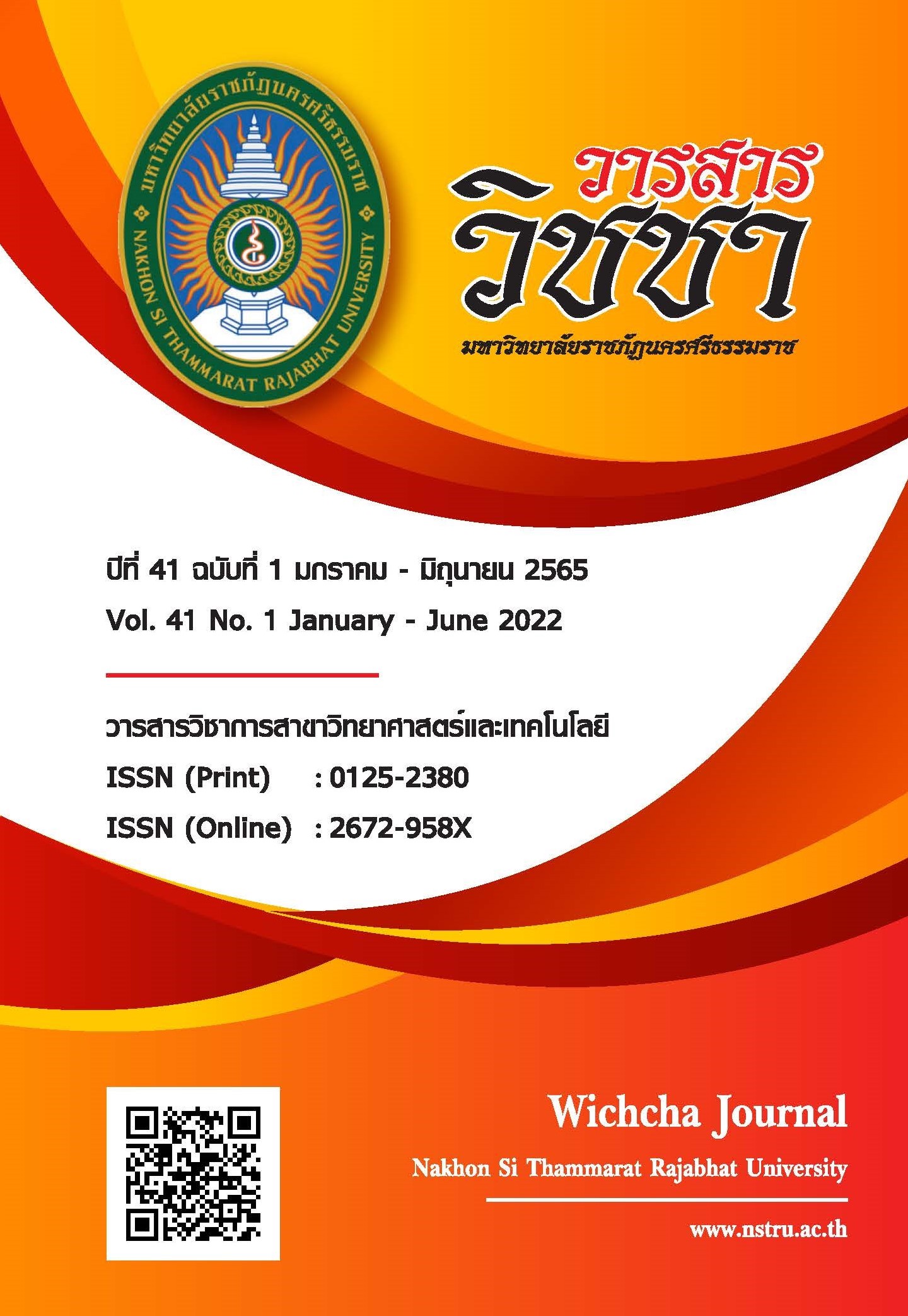Sterilization Methods to Prevent Contamination in MS Medium for the Tissue Culture of Philodendron “Cherry Red”
Main Article Content
Abstract
Currently there is great demand for ornamental plants in markets all over the world. There is a great desire in philodendron because it comes in a variety of colors and with interesting leaf shapes. This researchaims to study 9 easy methods of maintaining sterile cultures of philodendron in tissue culture systems when using culture medium prepared from instant MS (Murashige and Skoog) basic medium in powder form. The experimental plant was ‘Cherry Red’ philodendron. The treatments were control (autoclave), Haiter® bleach at 0.5 mg and 1.0 mg per liter, Betadine® disinfectant at 0.5 mg and 1.0 mg per liter, Physan20® fungicide at 0.5 mg and 1.0 mg per liter and ClO2® in tablet form at ½ tablet and 1 tablet per liter. Results showed that all treatments were effective in inhibiting contamination in culture medium. The best philodendron growth was observed with treatment 5 (Betadine® 1.0 ml/l), while treatment 7 (ClO2® 1 tablet/liter) resulted in the greatest number of new shoots (3.4 – 3.6), which was greater than the control (1.6) and the other treatments (1.2-2.2). Treatment 2 (0.5 ml/l Haiter®) resulted in the greatest growth of the clump at 41.04 mm, which was greater than the control (34.34 mm) to a statistically significant degree. The clump growth of all the other treatments ranged from 18.18 to 31.82 mm. The plantlets grown in medium sterilized with treatment 2 showed the greatest leaf size 12.29 x 23.92 mm. They achieved an average height of 27.72 mm with an average of 7.5 leaves and 8.7 roots per clump. However, this was not a statistically significant difference from the control at confidence level 95%. This research concludes that all tested treatments are effective in preventing contamination.
Article Details

This work is licensed under a Creative Commons Attribution-NonCommercial-NoDerivatives 4.0 International License.
เนื้อหาและข้อมูลในบทความที่ลงตีพิมพ์ในวารสารวิชชา มหาวิทยาลัยราชภัฏนครศรีธรรมราช ถือเป็นข้อคิดเห็นและความรับผิดชอบของผู้เขียนบทความโดยตรง ซึ่งกองบรรณาธิการวารสารไม่จำเป็นต้องเห็นด้วยหรือร่วมรับผิดชอบใด ๆ
บทความ ข้อมูล เนื้อหา รูปภาพ ฯลฯ ที่ได้รับการตีพิมพ์ในวารสารวิชชา มหาวิทยาลัยราชภัฏนครศรีธรรมราช ถือเป็นลิขสิทธ์ของวารสารวิชชา มหาวิทยาลัยราชภัฏนครศรีธรรมราช หากบุคคลหรือหน่วยงานใดต้องการนำข้อมูลทั้งหมดหรือส่วนหนึ่งส่วนใดไปเผยแพร่ต่อหรือเพื่อการกระทำการใด ๆ จะต้องได้รับอนุญาตเป็นลายลักษณ์อักษรจากวารสารวิชชา มหาวิทยาลัยราชภัฏนครศรีธรรมราชก่อนเท่านั้น
The content and information in the article published in Wichcha journal Nakhon Si Thammarat Rajabhat University, It is the opinion and responsibility of the author of the article. The editorial journals do not need to agree. Or share any responsibility.
References
กมลทิพย์ สำลีแก้ว อรพิมล แท่นทอง ผการัตน์ โรจน์ดวง และสุภาวดี รามสูตร. (2560). การขยายพันธุ์ข้าวพื้นเมืองพันธุ์กาบดำด้วยเทคนิคการเพาะเลี้ยงเนื้อเยื่อ. วารสารวิชชา มหาวิทยาลัยราชภัฏนครศรีธรรมราช, 36(2), 25-35.
ชญานีย์ สังวาลย์ ผการัตน์ โรจน์ดวง สุภาวดี รามสูตร ศุภมาส แซ่เดี่ยว และเสาวลักษณ์ ชูด้วง. (2558). ผลของสูตรอาหารต่อการเจริญเติบโตของเมล็ดเบญจมาศในสภาพปลอดเชื้อ. วารสารวิชชา มหาวิทยาลัยราชภัฏนครศรีธรรมราช, 34(2), 45-51.
ราฮีมา วาแมดีซา บักเร็น อาลี นุร์ซานีซา เจะดาโอะ และศุภณัฏฐ์ กาญจนวัฒนาวงศ์. (2564). การใช้สารเคมีฆ่าเชื้อเติมในอาหารสูตร MS เพื่อเพาะเลี้ยงฟิโลเดนดรอน “รวยทรัพย์” ในสภาพปลอดเชื้อ. วารสารมหาวิทยาลัยนราธิวาสราชนครินทร์, 13(1), 377-387.
ฤทัยชนก ชิตเดชะ พิมพ์โพยม บุญมา ผการัตน์ โรจน์ดวง และสุภาวดี รามสูตร. (2561). การขยายพันธุ์มะรุมโดยวิธีการเพาะเลี้ยงเนื้อเยื่อ (Moringa oleifera Lam.). วารสารวิชชา มหาวิทยาลัยราชภัฏนครศรีธรรมราช, 37(2), 86-95.
วรางคณา กาซัม มณีรัตน์ หวังวิบูลย์กิจ และนงนุช เลาหะวิสุทธ์. (2563). ผลของคลอรีนไดออกไซด์ต่อการทำให้ปลอดเชื้อในการเพาะเลี้ยงเนื้อเยื่อไวน์อดูเบียส. วารสารเทคโนโลยีการประมง, 14(1), 65-72.
วุฒิชัย ศรีช่วย และสมปอง เตชะโต. (2557). ผลของคลอรีนไดออกไซด์ต่อการทำให้ปลอดเชื้อในการเพาะเลี้ยงสับปะรดภูแลด้วยระบบไบโอรีแอคเตอร์. แก่นเกษตร, 42 (ฉบับพิเศษ 3), 75-80.
สุภัทราพร มหาแก้ว. (2536). ประสิทธิภาพของคลอรีนไดออกไซด์ในการลดปริมาณเชื้อ Salmonella typhimurium ในกระบวนการผลิตไก่แช่เยือกแข็ง. กรุงเทพฯ: มหาวิทยาลัยเกษตรศาสตร์.
Al-Otoum, F., Al-Ghauti, M.A. and Ahmed, T.A. (2016). Disinfection by-products of chlorine dioxide (chlorite, chlorate and trihalomethanes): Occurrence in drinking water in Qatar. Chemosphere, 164, 649-656, doi: https://doi.org/10.1016/j.chemosphere.2016.09.008.
Brondani, G., Oliveira, L., Bergonci, T., Brondani, A., França, F., Silva, A. and Gonçalves, A. (2013). Chemical sterilization of culture medium: A low cost alternative to in vitro establishment of plants. Scientia Forestalis, 41(98), 257-267.
Cardoso, J.C. and Silva, J.A.T. (2012). Micropropagation of gerbera using chlorine dioxide (ClO2) to sterilize the culture medium. In Vitro Cellular & Developmental Biology-Plant, 48(3), 362-368, doi: https://doi.org/10.1007/s11627-011-9418-8.
Chansean, M. and Syoichi, I. (2007). Conservation of wild orchids in Cambodia by simple aseptic culture method. In proceeding of Nagoya International Orchid Conference (page 13-19). Nagoya: Nagoya University.
Deein, W., Thepsithar, C., Thongpukdee, A. and Tippornwong, S. (2013). Growth of chrysanthemum explants on MS medium sterilized by disinfectants and essential oils. International Journal of Bioscience, Biochemistry and Bioinformatics, 3(6), 609-613, doi: https://doi.org/10.7763/IJBBB.2013.V3.286.
Gordon, G. and Rosenblatt, A.A. (2005). Chlorine dioxide: The current state of the art. Ozone Science and Engineering, 27(3), 203-207, doi: https://doi.org/10.1080/01919510590945741.
Huang, J., Wang, L., Ren, N., Ma, F. and Ma, J. (1997). Disinfection effect of chlorine dioxide on bacteria in water. Water Research, 31(3), 607-613, doi: https://doi.org/10.1016/S0043-1354(96)00275-8.
Habiba, U., Reza, S., Saha, M.L., Khan, M.R. and Hadiuzzaman, S. (2002). Endogenous bacterial contamination during in vitro culture of table banana: Identification and prevention. Plant Tissue Cult, 12(2), 117-124.
Lepelletier, D., Maillard, J.Y., Pozzetto, B. and Simon, A. (2020). Povidone iodine: Properties, mechanisms of action, and role in infection control and Staphylococcus aureus decolonization. Antimicrobial Agents and Chemotherapy, 64(9), doi: https://doi.org/10.1128/AAC.00682-20.
Loss-Oliveira, L., Sakuragui, C., Soares, M. and Schrago, C.G. (2016). Evolution of Philodendron (Araceae) species in Neotropical biomes. Peer Journal Life and Environment, 4, doi: https://doi.org/10.7717/peerj.1744.
Maris, P. (1995). Modes of action of disinfectants. Revue Scientifique et Technique, 14(1), 47-55, doi: https://doi.org/10.20506/rst.14.1.829.
Matsumoto, K., Coelho, M.C., Momte, D.C. and Teixera, J.B. (2009). Sterlization of non-autoclavable vessels and culture media by sodium hypochlorite for in vitro culture. Acta Horticulturae, 839, 329-336, doi: https://doi.org/10.17660/ActaHortic.2009.839.42.
McKeen, L. (2012). Introduction to food irradiation and medical sterilization. In Norwich, N.Y. and William Andrew. The effect of sterilization on plastics and elastomers ("3" ^"rd" edition). pp. 1-39. Waltham (Mass): Applied Science Publishers.
Pais, A., Silva, A., Souza, J., Teixeira, S., Ribeiro, J., Peixoto, A. and Paz, C. (2016). Sodium hypochlorite sterilization of culture medium in micropropagation of Gerbera hybrida cv. Essandre. African Journal of Biotechnology, 15(36), 1995-1998, doi: https://doi.org/10.5897/AJB2016.15405.
Russell, A.D. (2003). Similarities and differences in the responses of microorganisms to biocides. Journal of Antimicrobial Chemotherapy, 52(5), 750-763, doi: https://doi.org/10.1093/jac/dkg422.
Teixeira, S.L., Ribeiro, J.M. and Teixera, M.T. (2006). Influence of NaClO on nutrient medium sterilization and on pineapple (Ananas comosus cv Smooth cayenne) behavior. Plant Cell Tissue Organ Culture, 86(2006), 375-378. doi: https://doi.org/10.1007/s11240-006-9121-3.
Yanagawa, T., Nagai, M., Ogino, T. and Maeguch, M. (2006). Application of disinfection to orchid seeds, plantlet and media as a means to prevent in vitro contamination. Lindleyana, 10(1), 33-36.
Yang, X., Guo, W. and Lee, W. (2013). Formation of disinfection byproducts upon chlorine dioxide preoxidation followed by chlorination or chlorination of natural organic matter. Chemosphere, 91(11), 1477-1485, doi: https://doi.org/10.1016/j.chemosphere.2012.12.014.


